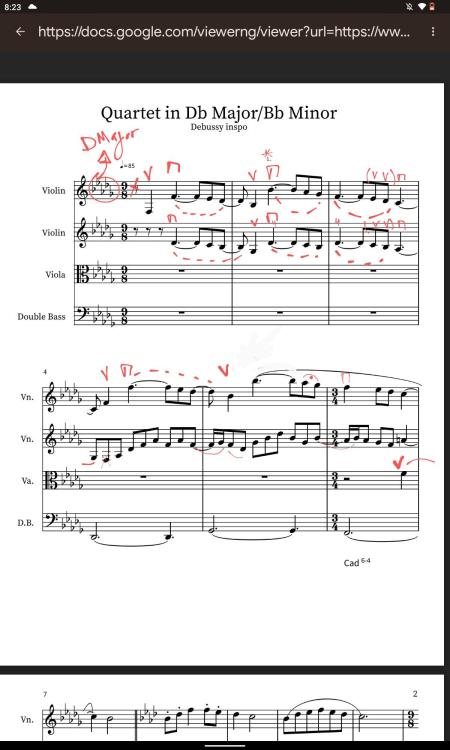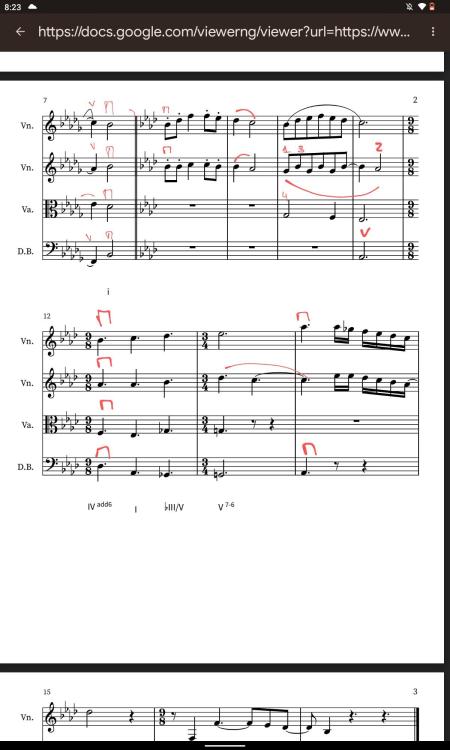Leaderboard
Popular Content
Showing content with the highest reputation on 05/10/2023 in all areas
-
Thanks for posting! I can say that, though the double bass stops at the end of the piece are technically playable, they are a bit awkward (particularly the D-F in m. 218-219) and I wonder if they are necessary. In general, dense voicing at the bottom of a chord can lead to muddiness. A more traditional voicing which might lead to a brighter sound would favor wide intervals (octaves and then fifths) on the bottom. In any case, I would probably recommend against using double bass stops in general unless you need that particular sound. If it's just the notes you want, they can be put elsewhere (such as low brass or bassoons). For me, the piece seemed to "find itself" at m. 116. The chordal passage which begins the piece also caught my attention, and the melodies from m. 9-45 flowed nicely. The piece became more nebulous between m. 46 and m. 115. Perhaps this could be a place to consider cuts? If that entire middle section was removed, the piece would feel to me like and introduction & chaconne... not sure if that's an actual form, but I think it could work well! And one miscellaneous note: I was a bit confused by the occasional strange time signature. They appeared between phrases, such as at m. 37, m. 45, and m. 149 (among others). The 6/4 at 149 seemed particularly confusing because for the following section I just ended up hearing beat 3 as beat 1, which caused m. 158 to sound a bit off when the stresses realigned with the bars. Hope this helps! I enjoyed listening.2 points
-
1 point
-
I felt a bit miserable, I hit record and improvised around a theme that suited my mood. Listening back, my ears wanted to hear the rising staccato motif played in counterpoint which would have sounded cool i think. The second improv is short and sweet, it sounds familiar somehow and it got me thinking about where in my mind the music comes from. Just as our personalities are a mixing pot of every person we've interacted with, our speech is like a kaleidoscope of all the conversations we've had, our music when played on the fly must be like the twisting of a kaleidoscope where all the colourful pieces are just getting mixed about.1 point
-
I have always thought that it is very subjective to set an image to music. However, I believe that because of so many learned patterns already, it is possible. Certainly this image takes you to a dystopian world, and the overall result seems to me to be quite in keeping with it. Maybe because of the percussion, some unexpected harmonic twists, the minor key in general... And I agree about the cello at the end.1 point
-
Much has already been said about the piece. For me, many things stand out, such as the continuous contrary movement and the feeling of fullness that is achieved with two voices (except in passages with fuller chords). Also the fluidity of the ensemble. Bravo.1 point
-
Hi Alex, I like this movement. It has vivacity in it as always present in your work. I particularly love your modulation, like in b.89-101 and the ending one modulate to C minor and Eb minor. I think they are perfectly fine for me! For me I am completely opposite of what @pijanowski-kangas suggests! (Sorry!) I love the sections before b.115, but when it comes after it I feel there are too many repetitions without development. I agree it's quite Chachonne with similar harmonic progression even it's in 4/4 time, but I feel like the theme is also unchanging there. With an underlying harmonic structure I think at least the thematic materials have to be more varied to balance it. My interest only arouses when it comes to the C minor section in b.190. You can also use a 6 flat key signature in b.206 to signify the Eb minor there! I think the best way to decide what to reduce is to map out the structure first and decide the length of each part of it. Thanks for sharing Alex! Henry1 point
-
They aren't just difficult, their Impossible to play. The intervals are incredibly large, and would require a massive painful stretch I don't think I could do, and I have long fingers and a long palm.1 point
-
PeterthePapercomPoser, Thanks. I think it's interesting what you said about some composers using piano rolls over traditional notation. For someone like me, I wouldn't be able to produce anything without the colorful block puzzle that is the piano roll (in my case Sonar). I admire those of you who can read music. I wish I could. I've tried but it's hopeless. I love math and to me calculus is easier than reading music. And calculus is hard! So consider yourself fortunate if reading music is part of your muscle memory. That's a lot of power and music preservation would be lost without notation. I sooo wish I could just snap my fingers a read and write music on a staff, but like I said... I'm hopeless in that regard. That just leaves me with my ears and that colorful blocky grid. It's literally taken me years to get comfortable using Sonar. And I'm still barely scratching the surface of what it can do! Thanks again, it's very kind that you think I must be doing something right. Funny, because in reality I'm probably doing everything wrong *hehehe*! -Rick1 point
-
1 point
-
Hi Peter, I've actually made changes since the last post(https://drive.google.com/drive/u/0/folders/19gXnaZlSKRurEp3iXgNITQY0VPfYPWvj), much better overall I think. Sorry to hear you didn't like the piece. I was actually one of the early viewers when it first came out on Lionel Yu's channel(few years ago), it was featured with one of his other piece called "Debbie's march". The waltz struck me as being very beautiful, and I recently rediscovered around early 2023. No one attempted to orchestrate Rizal's work(apart from himself) so I felt it'd be a good idea to make history. This is also an exercise to hone my newfound abilities in orchestration, and it was great fun transcribing/re-imagining different ways to enliven the piece. So to answer your question, I think it's a combination of both sentimental and educational reason.1 point
-
Hey Daniel and Henry, I know this thread is probably past relevant to you two now; I've been so busy with school and the recent competition that I've procrastinated on this for quite some(actually a lot) time. Thank you to Peter for bringing this to thread to my attention once again. I am happy you guys enjoyed my arrangement. Unfortunately, the composer never acknowledged my fruit of labor, but I hope that this arrangement will find its way to whoever needs it. Here is one more banger to listen to:1 point
-
1 point
-
Thanks for checking this out bro. This was a weird one to write, as I just kept writing and developing that motif until I decided to stop. I just wanted a mostly high energy piece since the last 2 will be slower. I think you're the only one that's commented on all of these so far, what say you about the balance and variety? I just realized the repeating Ab IS the same as in the raindrop prelude. Nice catch. People keep mentioning Prokofiev in these comments. I try to listen to his music but I just can't make it through a whole piece. There's probably something wrong with my brain. Is there a piece by him that you'd recommend to get into his style? Thanks again Henry. You're dashing1 point
-
Hey Vince, For me this is a sophisticated display of cohering with motive here. The repeated note and the anapestic motive are everywhere but they give a very humorous effect rathet than a robotic one! It does have some improvistaory sections but all of them are linked with your motivic usage! The beginning is really like Beethoven's Waldstein in my opinion! The imitation in b.25 is very funny. It's like you are trying to pretend to write contrapuntally but just ignore it in the middleway! I love the passage in b.48 with the repeated motive on Gb seperated, and your voicing is great there. It looks like it's random but no since here it's for me like the melody of a Bach solo violin piece with different voices in one individual line. That repeating Ab in b.86 lento section provides good contrast. Even though it comes from the beginning, it certainly reminds me Chopin's raindrop prelude when Ab is repeated! I feel like the tempo is a little bit slow here and maybe an Adagio is better? Again I like those quartal chords in b.141! I love the way how you force that Ab major chord ending! It seems out of place in a very good way! Just like the ending of the first movement of Prokofiev's Piano Sonata no.6 the A major is forced or his no.7 when the Bb major is forced! It seems very ironic to achieve a major chord ending here in my opinion which creates dramatic effect! Your fault is asking others to comment your faults LoL! For sure I enjoy this one and thx for sharing! Henry1 point
-
This is a topic too big to explore with forum posts, but it is primarily a matter of composition, and secondly a matter of sample usage. The "epic" trailer style is derided by more traditionalist orchestrators and composers precisely because originality within it is very difficult given the defining characteristics of the genre are quite rigid, and secondly: It takes the "pop song for orchestra" approach, which is not idiomatic to the ensemble and therefore winds up not sounding very orchestral at all. This manifests here (and in other tracks in the style) in the string ostinato, which is an attempt to apply the "chord progression" pop song, piano broken-chords style writing to the accompaniment/harmony in a way that dodges sample limitations. What's happening is that your accompaniment is constantly moving; jumping around in pitch against the brass line, but it is not moving homorhythmically, nor is it moving parallel, oblique or contrary to the main line. It also sounds like it is in much the same range as the brass, and thus: The brass line is muddied. The other thing is that it sounds like you have everything going full blast at all times. If everything is loud, then nothing is loud. So the dynamics need to be tweaked overall, but the melodic lines need more crescendo and decrescendo; with a sustain line, you want to ride the modwheel a fair bit. The next problem is that the theme is totally forgettable because it is exclusively legato/sustain, so it lacks a sense of pulse and the rhythmic structure of a melody is one of the most vital aspects, especially for anything jaunty or what I would call "epic". For example, if you take your keyboard and you play the C major scale descending, one note at a time, it just sounds like a boring scale. Do the same, but add the right rhythm to it and you get "Joy To The World", one of the most famous melodies out there. In short: You need to use a combination of short and long articulations, and certain notes need a clear emphasis in attack to determine the pulse and pattern clearly; something that just can't be done with exclusively-long notes. But this is an extremely common problem with modern virtual orchestration: Using different articulations to create something that sounds musical since most libraries are recorded in a very dumb manner that doesn't create much homogeneity between samples. What you will be forced to do is layer articulations like a staccato over the legato patch, but the success of this varies greatly from library to library. It took me almost 15 years to find a combination of libraries that really work well together for writing the 20th Century Styles I specialize in. If it were my piece, I'd probably do the following: • Remove the string ostinato as accompaniment and instead choose harmony according to each individual note of the theme and give this a separate rhythm that contrasts but supports the main theme and plays at a softer dynamic • Make the bassline work contrapuntally to the theme, utilizing a lot of contrary motion. A pedal tone could be tasteful in spots. • On first introduction of the theme, have the entire ensemble quieter and double the brass, either in the same section or different, but I'd utilize sixths, thirds or octaves. If it were solely brass, parallel fifths in spots could be good too. • Add more attack to the melody by layering in some short notes, maybe even doubling with pitched percussion. • Add call and response and other flourishes and orchestral flair during the last couple beats of the sustained notes in the theme to create more motion and interest • Have different parts of the theme stated by different sections and doublings, within the same phrase. I hope some of these ideas help.1 point








.thumb.jpg.e5f26b712b4f9622f521b10d8a53c6d6.jpg)

